


Model Estate 2021


Welcome to the 2021 Model Estate research report, the eleventh annual publication produced by Carter Jonas, which documents the frequently changing nature of a rural estate and its diverse range of income streams.
About the Model Estate
The Model Estate is a notional agricultural estate created by Carter Jonas in 2010. The Estate has evolved over the years and currently comprises 3,168 acres and includes a combination of let and in-hand farms, a commercial and residential portfolio, a telecoms mast, fishing rights, a syndicate shoot, a solar farm, and a quarry. It is located within the geographical triangle bounded by the M4, M40 and M5 motorways.
Why was the Model Estate created?
Analysing the Estate’s data each year enables us to give a balanced view of
all the assets and make strategic recommendations for the coming months, similar to the annual reviews produced by Carter Jonas for estates under our management.
The Model Estate is also used to compare the short- and long-term capital value performance of agricultural land and assets against
a basket of alternative asset classes: residential and commercial property, equities, gold, fine wine and classic cars.
Please note that all findings in this report are based on valuations undertaken on 31 December 2020.
Components
Total value:
£44.36 million
Annual change:
+11.6%
The Model Estate was valued at £44.36 million in December 2020, representing an annual increase of 11.6%. This substantial rise was driven by the introduction of a quarry (sand and gravel), which replaced 25 acres of let farms, consequently impacting on the sub-sector’s performance. Positive performance across both the in-hand farms and the residential assets were also contributors, while the value of the commercial portfolio remained unchanged.





Let farms 32%
Let commercial 9%
In-hand farms 41%
Let residential 7%
Other 11%
Figure 1 Components of the Model Estate (by capital value)
Source: Carter Jonas










Let residential
Let commercial
In-hand farm
Other
Let farms
Explore the Model Estate

SOLAR FARM
TELECOMS MAST
FISHING RIGHTS
SYNDICATE SHOOT
Other
SOLAR FARM
SYNDICATE SHOOT
FISHING RIGHTS
TELECOMS MAST
MANOR HOUSE
FARMHOUSE
In-hand farm

FARMHOUSE
MANOR HOUSE

Let commercial
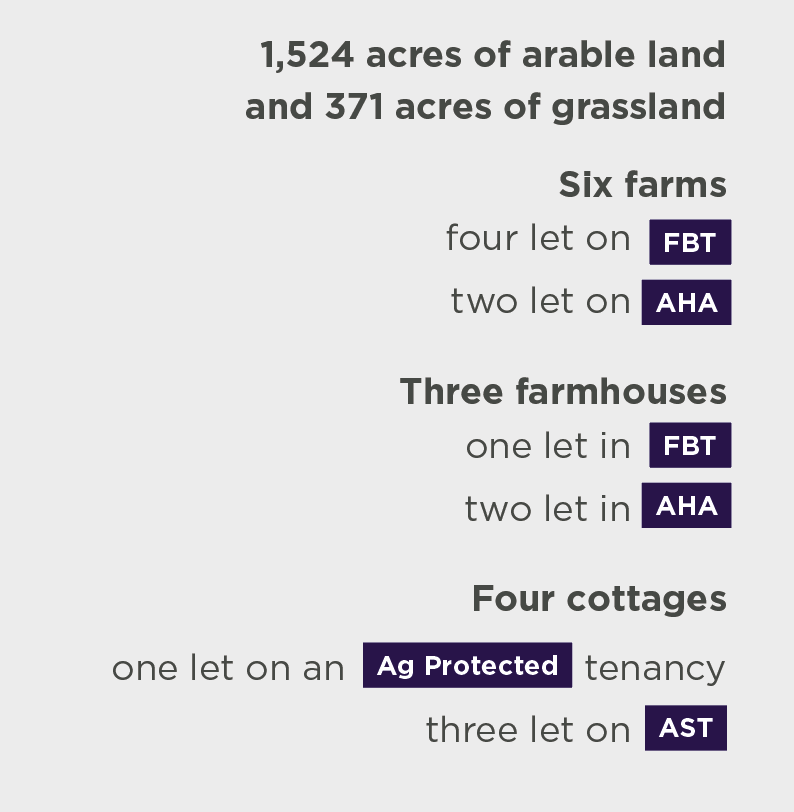
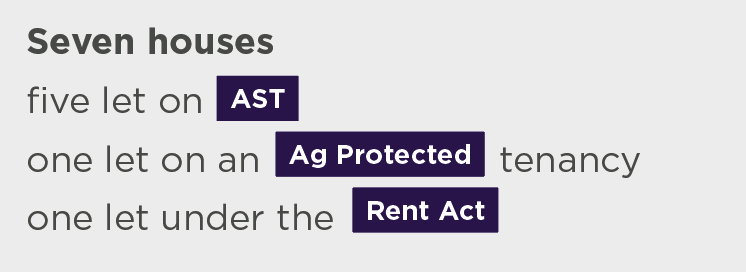
Let residential
AST
AST
FBT
FBT
FBT
FBT
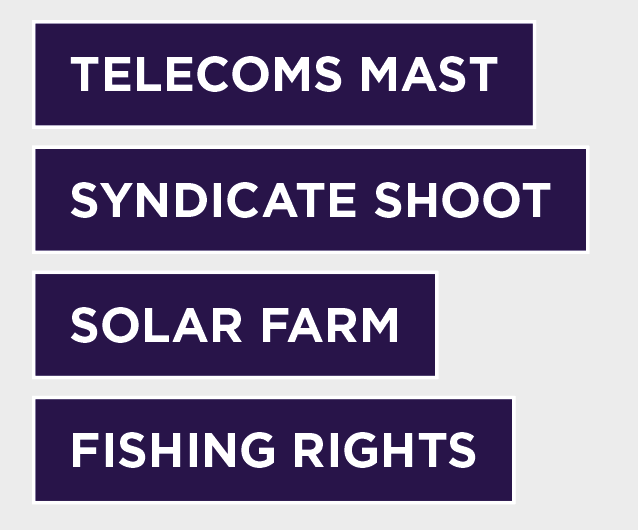
Let farms
Show all components
Performance
Despite the turbulent economic climate created by the Covid-19 pandemic, the Model Estate yet again proved its resilience with its value increasing to £44.4 million at December 2020 from £39.8 million in 2019, an 11.6% increase during the year.


Figure 2 Model Estate Performance
Source: Carter Jonas
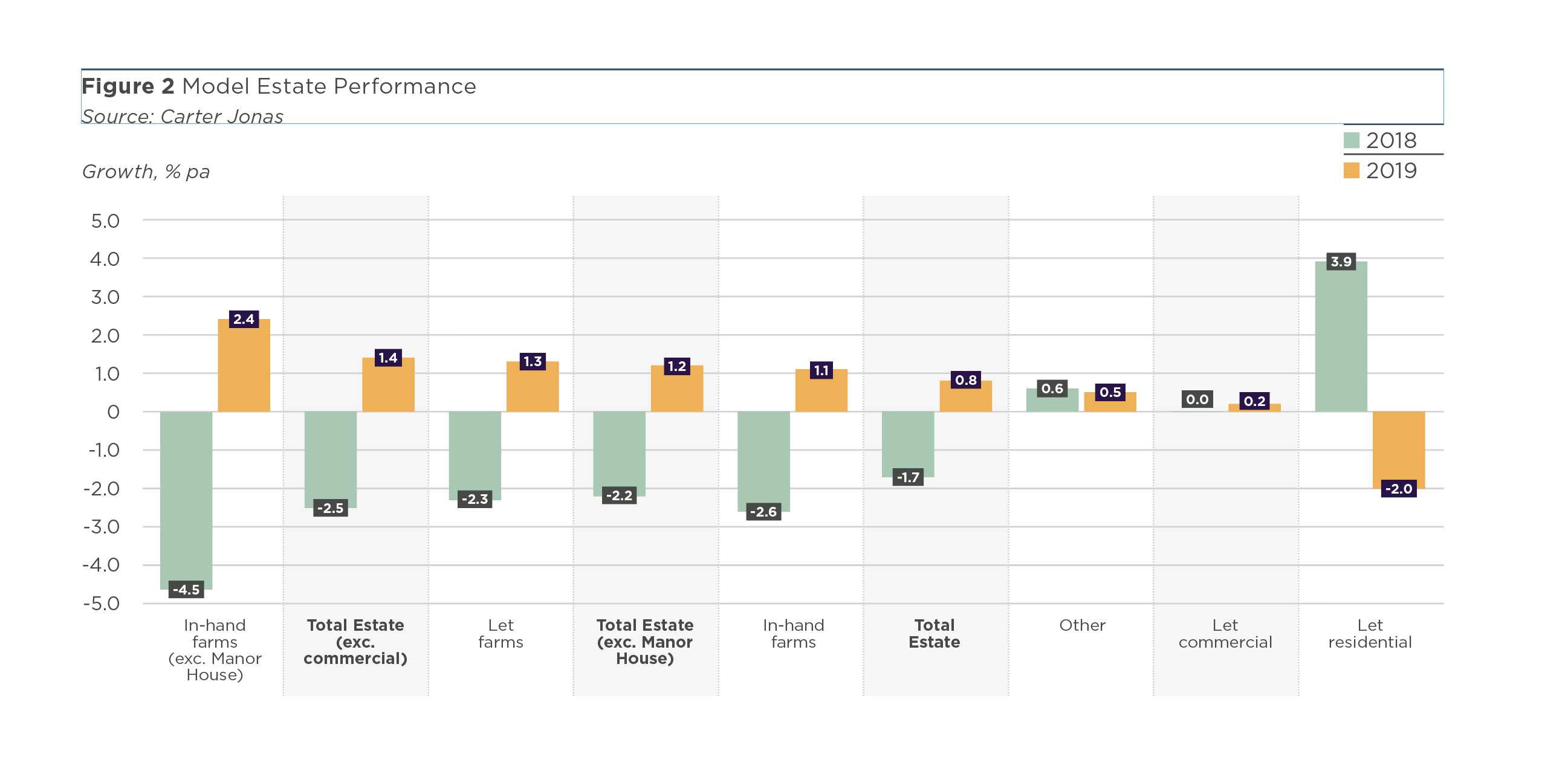
Growth % pa
5.0
4.0
3.0
2.0
1.0
0.0
-1.0
-2.0
-3.0
-4.0
-5.0
In-hand
farms (exc. Manor
House)
Total
Estate
(exc. commercial
Let
farms
Total
Estate
(exc. Manor House)
In-hand
farms
Total
Estate
Other
Let commercial
Let residential
2.4
-4.5
-2.5
-2.3
-2.2
-2.6
0.6
0.0
-1.7
3.9
1.4
1.3
1.2
1.1
0.8
0.5
0.2
-2.0
2018
2019
Other: 650%
The Estate’s impressive growth was primarily driven by the introduction of a quarry, following a successful planning process, which was the sole reason for this sub-sector’s exceptional increase. The quarry had a 2020 year-end value of £4.4 million and an annual income of £542,500; a detailed description of this component and its financial contribution is contained in the next section.
In terms of the other elements of the sub-sector; the solar farm’s capital value increased by 8.8% over the last year while the value of the telecoms mast, commercial shoot and fishing rights all remained stable.
Residential: 4.0%
The residential element of the Estate had a 4.0% increase in capital value over the year. All seven properties which comprise the portfolio remained occupied with rental levels holding firm. This positive trend is in line with the national picture which has seen demand strengthen for good quality, well located residential property with good internet connection remaining a key driver. This strengthening in demand is forecast to continue after restrictions
have been lifted from the Covid-19 pandemic, as flexible working combined with improved quality of life will remain key factors in the decision to relocate.
In-hand Farms: 1.3%
The in-hand element of the Estate saw values rise by 1.3% in 2020, slightly above the 1.1% recorded in the previous year. The increase was entirely due to the Manor House and the one farmhouse included within this sub-sector. The value of the arable land remained stable, although pasture land values fell by just over 3% over the last twelve months.
In contrast to previous years, the value of the Manor House materially improved the performance of the in-hand farms in 2020, with a return of 1.3% when included, and no change being recorded when excluded. This demonstrates the strengthening in demand and values of the national country house market as an increasing number of people consider relocating to more rural locations for an improvement in quality of life, due to the impact of the global pandemic and the consequent change in working patterns.
The hot, dry weather in the spring significantly reduced harvest yields in 2020. However, commodity prices witnessed a notable increase as a result of Brexit, and have continued to remain high offsetting, in part, the impact of a low yielding harvest. The downward tapering of BPS has continued to squeeze farm income across the board, placing pressure
to diversify, find alternative income streams, and
reduce costs.
Commercial: 0.0%
The commercial element of the Estate remained fully occupied and values held stable over the last year. In light of the pandemic, this is a very positive outcome, with all tenants remaining able to pay full rent despite the increasingly difficult economic conditions.
Letting activity has proved restrained across the major UK cities relative to previous years, although not at the catastrophic levels which were feared at the beginning of the pandemic. Good quality space in rural locations with good internet connections continue to be in demand with rental increase forecast for the remainder of 2021.
Let Farms: -1.4%
The let farms portfolio was the only element of the Estate which recorded a decline in values in 2020. However, this drop was due to a reduction in area of 25 acres, as a result of the quarry being opened up and subsequently being taken out of agricultural production.
The value of the residential element of the let farms increased by just over 3% in the last 12 months, with arable land values holding stable in contrast to pasture land values declining by 3.3%.
Read more on the Model Estate...

Find out more from our experts about mineral extraction on the Model Estate, and how to maximise the value of subsequent leisure opportunities.

Mining for minerals
Performance
How did the Model Estate rank amongst the alternative asset classes?
Alternative Asset
Class Rankings




Scroll to explore

Scroll to explore

Scroll to explore
For an interactive map showing all of the components of the Model Estate 2021 visit this page on desktop
Annual change:
+11.6%









700
Other
Total
Estate
(exc. commercial
Total
Estate
(exc. Manor
House)
Total
Estate
Let Residential
In-hand Farm
In-hand Farm
(exc. Manor House)
Let commercial
Let Farms
600
500
400
300
200
100
0
-100
649.6
15.0
13.2
11.6
4.0
1.3
0.0
-1.4
0.0
16
Total
Estate
(exc. commercial
Total
Estate
(exc. Manor
House)
Total
Estate
Let Residential
In-hand Farm
In-hand Farm
(exc. Manor House)
Let commercial
Let Farms
14
12
8
6
4
0
-2
-4

2
10
15.0
13.2
11.6
4.0
1.3
0.0
0.0
-1.4
Other: 650%
The Estate’s impressive growth was primarily driven by the introduction of a quarry, following a successful planning process, which was the sole reason for this sub-sector’s exceptional increase. The quarry had a 2020 year-end value of £4.4 million and an annual income of £542,500; a detailed description of this component and its financial contribution is contained in the next section.
In terms of the other elements of the sub-sector; the solar farm’s capital value increased by 8.8% over the last year while the value of the telecoms mast, commercial shoot and fishing rights all remained stable.
Residential: 4.0%
The residential element of the Estate had a 4.0% increase in capital value over the year. All seven properties which comprise the portfolio remained occupied with rental levels holding firm. This positive trend is in line with the national picture which has seen demand strengthen for good quality, well located residential property with good internet connection remaining a key driver. This strengthening in demand is forecast to continue after restrictions have been lifted from the Covid-19 pandemic, as flexible working combined with improved quality of life will remain key factors in the decision to relocate.
Commercial: 0.0%
The commercial element of the Estate remained fully occupied and values held stable over the last year. In light of the pandemic, this is a very positive outcome, with all tenants remaining able to pay full rent despite the increasingly difficult economic conditions.
Letting activity has proved restrained across the major UK cities relative to previous years, although not at the catastrophic levels which were feared at the beginning of the pandemic. Good quality space in rural locations with good internet connections continue to be in demand with rental increase forecast for the remainder of 2021.
Let Farms: -1.4%
The let farms portfolio was the only element of the Estate which recorded a decline in values in 2020. However, this drop was due to a reduction in area of 25 acres, as a result of the quarry being opened up and subsequently being taken out of agricultural production.
The value of the residential element of the let farms increased by just over 3% in the last 12 months, with arable land values holding stable in contrast to pasture land values declining by 3.3%.
Figure 2 Model Estate Performance
Source: Carter Jonas
Growth % pa
2020
Figure 2 Model Estate Performance
Source: Carter Jonas
Growth % pa
2020



In-hand Farms: 1.3%
The in-hand element of the Estate saw values rise by 1.3% in 2020, slightly above the 1.1% recorded in the previous year. The increase was entirely due to the Manor House and the one farmhouse included within this sub-sector. The value of the arable land remained stable, although pasture land values fell by just over 3% over the last twelve months.
In contrast to previous years, the value of the Manor House materially improved the performance of the in-hand farms in 2020, with a return of 1.3% when included, and 0.0% being recorded when excluded. This demonstrates the strengthening in demand and values of the national country house market as an increasing number of people consider relocating to more rural locations for an improvement in quality of life, due to the impact of the global pandemic and the consequent change in working patterns.
The hot, dry weather in the spring significantly reduced harvest yields in 2020. However, commodity prices witnessed a notable increase as a result of Brexit, and have continued to remain high offsetting, in part, the impact of a low yielding harvest. The downward tapering of BPS has continued to squeeze farm income across the board, placing pressure to diversify, find alternative income streams, and reduce costs.
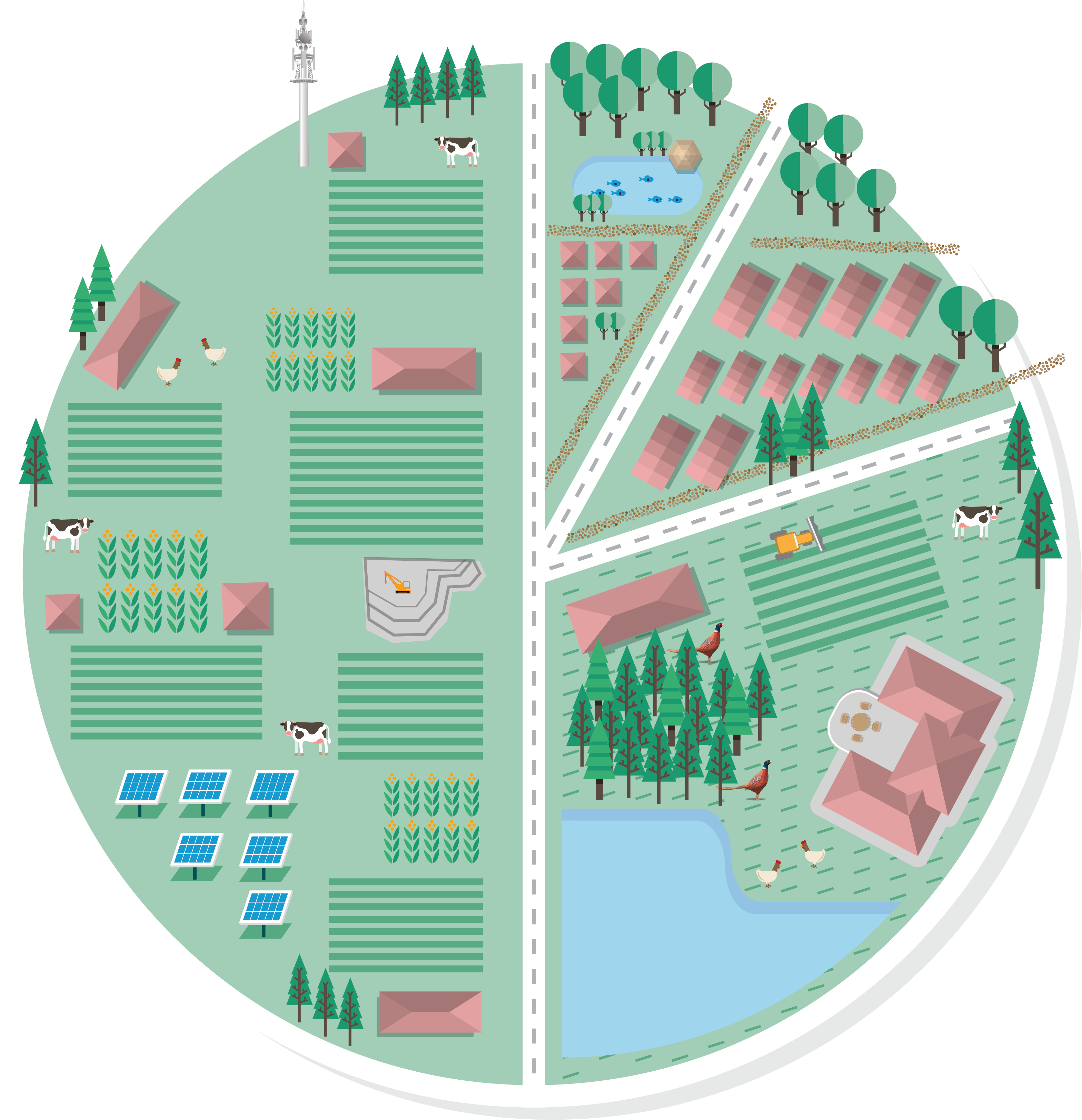
QUARRY
QUARRY
Contact us for more information
EMAIL HEENA
020 7518 3270
Research Analyst
Heena Gadhavi


EMAIL CATHERINE
01604 608203
Rural Consultant
Catherine Penman

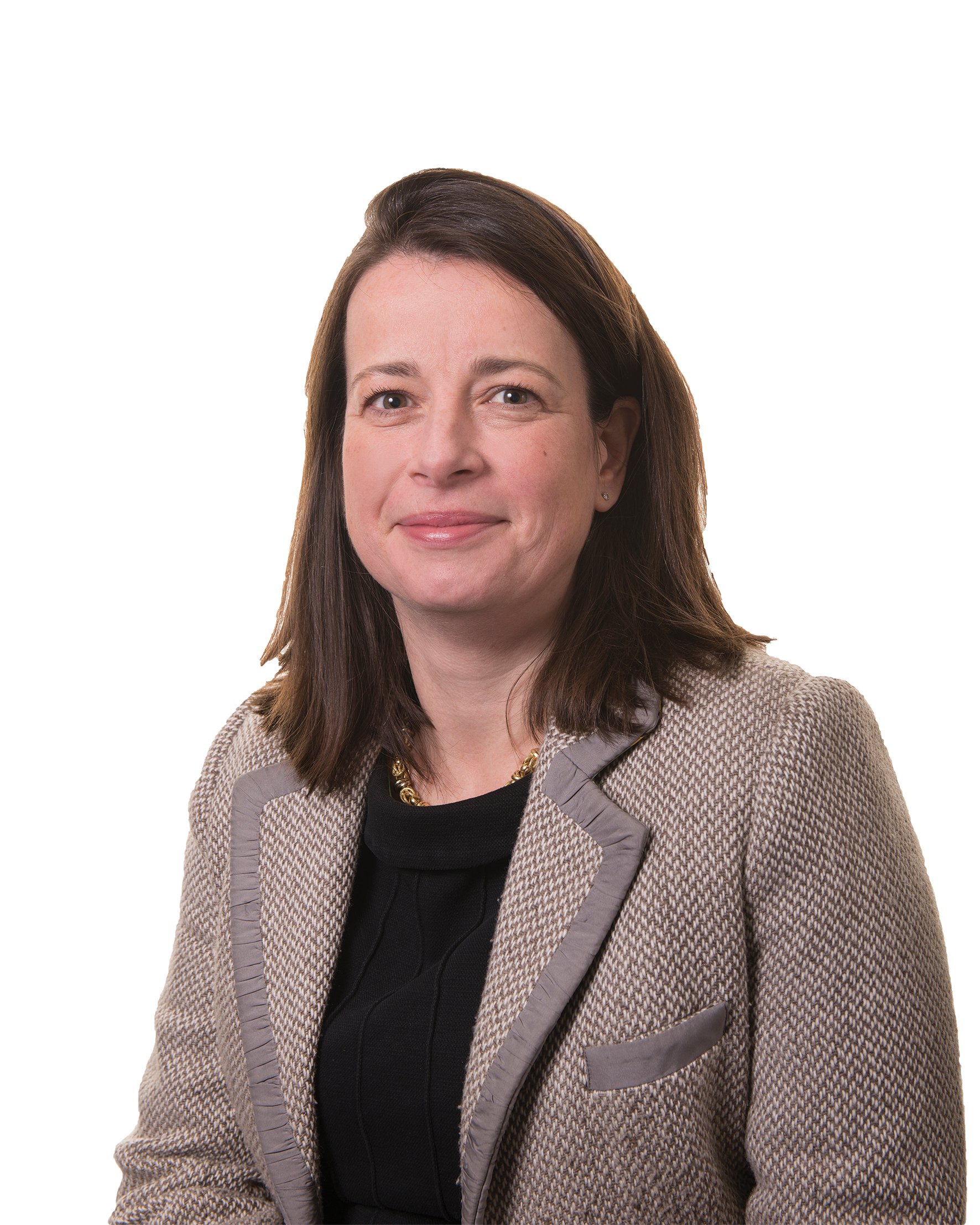
EMAIL TIM
01223 346609
Head of Rural Division
Tim Jones




EMAIL HEENA
020 7518 3270
Research Analyst
Heena Gadhavi


EMAIL CATHERINE
01604 608203
Rural Consultant
Catherine Penman

EMAIL TIM

01223 346609
Head of Rural Division
Tim Jones

Contact us for
more information